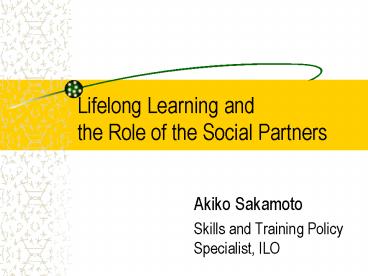Lifelong Learning and the Role of the Social Partners - PowerPoint PPT Presentation
1 / 13
Title:
Lifelong Learning and the Role of the Social Partners
Description:
Lifelong Learning and. the Role of the Social Partners ... Equal, if not greater, emphasis on continuous and non-formal skills ... as a main place for ... – PowerPoint PPT presentation
Number of Views:26
Avg rating:3.0/5.0
Title: Lifelong Learning and the Role of the Social Partners
1
Lifelong Learning andthe Role of the Social
Partners
- Akiko Sakamoto
- Skills and Training Policy Specialist, ILO
2
Lifelong learning Concepts
- all types of learning
- takes place throughout ones life
- goals
- improved employability
- active citizenship
- social inclusion
- personal development
- driven by both economic and social concerns
3
Implications for education and training system
- Equal, if not greater, emphasis on continuous and
non-formal skills development - Increased importance of learning at work
- Quality initial learning, as initial learning
creates foundation for learning in subsequent
stages (importance of basic/foundation skills) - Recognition of all types of learning including
informally acquired skills and knowledge
4
What does lifelong learning imply? (cont.)
- Expansion of learning opportunities to all,
notably those with no/limited skills and
education - Requires innovative and diverse approach to the
delivery of education and training (e.g.
self-directed, distance learning, flexible,
modular- based short training, credit
accumulation) - Different ways of thinking, commitment and
synergies required for developing the skills
development system
5
Increased importance of social partners
- Workplace as a main place for learning
- Enterprises are at the forefront of technology,
innovation, and competitions - Social partners witness changing skills demands
- Skilling the workforce is of mutual interest for
both employers and trade unions (to offset
declining membership and also as part of their
work of promoting job security)
6
What can social partners do?
- Employers (at the enterprise level)
- Provision of education leave (e.g. France, UK,
Germany, Italy) - Delivery of employer-sponsored training
- Financial assistance to employee training
- Sector-based agreement to peg wages to levels of
qualifications in given occupation - Appointment of learning facilitators in the
workplace (UK, S. Africa) - Give greater autonomy and labour relations that
promote sharing skills and knowledge, and career
progressions
7
What can employers do? (cont.)
- System level employers involvement
- Active participation in developing skills
standards, curricula and undertaking
certification - Offer work placements for trainees
- Direct management of vocational training
institutions (e.g. SENAI -Brazil, ICIC -Mexico,
INACAP -Chile, INFOCAL Bolivia) - Involvement in governing board of training
institutions - Substantial participation in policy making
regarding training
8
What can workers organizations do?
- At the enterprise level
- Ensure equal access to training opportunities
- Ensure certification is impartial and transparent
(prevent misuse) - Active agents in enterprise promoting learning
- Organize and offer training services (e.g. basic
skills training, learning centres, UK)
9
What can workers organizations do? (cont.)
- System level workers involvement
- Inclusion of skills dev. in collective agreements
- Active participation of trade union reps. in
tripartite bodies and policy making regarding
skills development - Direct management of vocational training
institutions (e.g. Construction Training
Foundation, Argentina) - Involvement in governing board of training
institutions - Research (Inter-union Dept. of Statistics
--Brazil, Argentina)
10
Current situation and challenges
- Sizeable increase in employee participation in
training (increase from 26 to 41 in Belgium,
24 to 41 in Netherlands, 25 to 26 in Italy in
1993-1999) - Also investment in training by employers still
depends on size of company, business strategy,
products - Sizable success but still challenges for trade
unions - Union reps not able to dedicate full time effort
and required to work outside of normal hours
11
Current situation and challenges 2
- but where government and employers support
exists, then trade unions can have substantial
impact (e.g. union learning funds, UK)
12
Issues for India
- of workforce in formal economy very small (7)
- low coverage by trade unions and employers
organizations/business associations - what does that imply for role of government
vis-à-vis social partners in lifelong learning? - role of cluster associations (workers or
employers) - formal enterprises providing training of informal
suppliers (as competitiveness strategy)
13
Thank you































